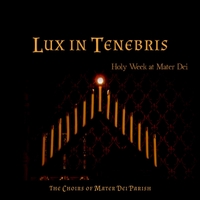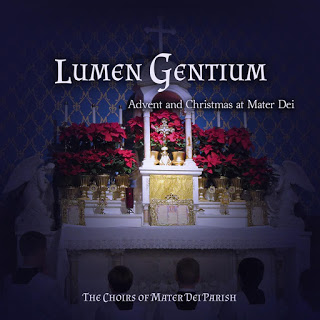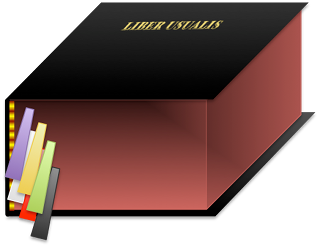This is the first in a series of posts I hope to make on how to sing Gregorian Chant. In this post, we will introduce theoretical concepts which we will put into practice in later posts. At the end of this series of primers, hopefully, you will be well on your way to understanding how to read and sing Gregorian Chant.
Gregorian Chant Notation: What Chant Looks Like
Let’s begin by taking a look at the big picture of what we are trying to learn. Below is an example piece which I have chosen because it has many important building blocks which we will delve into later. For now, let us consider the piece as a whole.
Probably the first thing you will notice is that there are various blobs of ink, some of them larger than others, that are quite different from the whole, half, quarter, and eighth notes of modern music notation. As you look at the piece a bit closer, you’ll notice also that there are only four staff lines unlike the five lines of the modern staff.
Keep calm. Chant notation is actually not as complex or bizarre as it may first appear. Let’s start at the beginning and take a look at each element from left to right:
- Type
- Mode
- Lyrics
- Clef
- Neums
- Notes
- Asterisk
- Quarter Bar
- Custos
- Full Bar
- Salicus
- Comma
- Quilisma
- Half Bar
- Flat
- Verse/Double Bar
- Horizontal Episema
- Isolated Punctum
First, we see the word “Tract”. This is simply telling us what kind of piece we are singing. A tract is sung after the Gradual from Septuagesima until the end of Lent. There are also other times where a tract may be sung apart from a Gradual, but it is most common for a tract to appear after the Gradual in lieu of the Alleluia (which is not said/sung from Septuagesima until Easter). Knowing what type of piece you are singing is important because some chants have implicit repetitions. The first line of an Alleluia, for example, is repeated after the verse is concluded. A tract, however, ends with the last verse.
Beneath the word “Tract” is a number, in this case, the number 8. This number indicates the mode of the piece. The mode ranges from 1 to 8 and tells us generally what the piece will sound like and how the piece is likely to end. Modes 1-4 have a minor sound, while modes 5-8 have a major sound.
Beneath the mode indicator is the first letter of the lyrics. In the example piece, the lyrics begin, “Beatus vir”. You will notice that the lyrics appear beneath the notes that are sung with them. In particular, you will notice that the vowel sound of each syllable appears directly below the first note on which that vowel sound is sung. An accent mark appears over many of the syllables. The accent mark comes from the Latin text and falls on the second-to-last or third-to-last syllable in each word. Words containing only one syllable do not have an accent mark.
The accent mark is important when singing plainsong, such as psalms. Here, the rhythm follows the accented syllables. In the above example (the “full chant melody”), however, the rhythm follows the ictus. We’ll delve more into rhythm in a later post. For now, suffice to say that in plainsong, the rhythm tends to follow the words, whereas in the full chant, the rhythm tends to follow the melody.
Below are the pronunciation rules for vowels, as given in the Liber Usualis (page xxxvii):
- A is pronounced as in the word Father, never and in the word can. We must be carful to get this open, warm sound, especially when A is followed by M or N as in Sanctus, Nam, etc.
- E is pronounced as in Red, men, met; never with the suspicion of a second sound as in Ray.
- I is pronounced as ee in Feet, never as i in milk or tin.
- O is pronounced as in For, never as in go.
- U is pronounced as oo in Moon, never as u in custom.
- Y is pronounced and treated as the Latin I.
- As a general rule, when two vowels come together, each keeps its own sound and constitutes a separate syllable. (diei is di-e-i; filiis is fi-li-is; eorum is e-o-rum). This applies to OU and AI (prout is pro-oot; ait is ah-eet).
- AE and OE, however, are pronounced as one sound, like E above.
- In AU, EU, and AY, the two vowels form one syllable but but vowels must be distinctly heard.
Moving to the right of the mode, we see an ink blot on the top line. This is the clef. The clef may be either a Do clef (C-clef) ![]() or a Fa clef (F-clef)
or a Fa clef (F-clef) ![]() . The purpose of the clef is to indicate where the solfege note Do or Fa is, and from there, what are the solfege notes of the remaining lines and spaces on the staff. In our example, Do is shown to be the top line. Therefore, the spaces and lines beneath are Ti, La, Sol, Fa, Mi, Re, and Do respectively. The space above is Re. As with modern notation, ledger lines may be used if the notes rise above the space above the top line or fall below the space below the bottom line. We will write more on solfege in a later post.
. The purpose of the clef is to indicate where the solfege note Do or Fa is, and from there, what are the solfege notes of the remaining lines and spaces on the staff. In our example, Do is shown to be the top line. Therefore, the spaces and lines beneath are Ti, La, Sol, Fa, Mi, Re, and Do respectively. The space above is Re. As with modern notation, ledger lines may be used if the notes rise above the space above the top line or fall below the space below the bottom line. We will write more on solfege in a later post.
Unlike in modern notation, the chant clef can be placed on any of the top three lines. Thus, the top line is not always Do. Also unlike modern notation, the clef does not indicate any absolute pitch (A, B, C, etc). This allows the choir to set the pitch of Do or Fa to a note that puts the piece in a comfortable range. Hence, the choir may decide to set Do to B-flat, C, or whatever pitch is expedient.
Now we come to the blobs of ink placed on the lines and spaces of the staff. These are groupings of notes called neums (pronounced nooms). The neum is a set of notes (at least one) sung on a single syllable. Sometimes on longer passages, multiple neums are joined together on the same syllable, as in the word nimis on the third line or the third syllable of Dominum on the second line. There are a dozen or so different neums (not including compound neums or variations on the same neum). We will delve into those in greater detail in a later post.
The notes comprising neums are read from left to right and, when stacked, from bottom to top. There is one exception to the bottom-to-top rule called the Cephalicus  . Technically, one could say that the first note sung is slightly to the left of the second note. Anyhow, let’s not be concerned about the exception for now.
. Technically, one could say that the first note sung is slightly to the left of the second note. Anyhow, let’s not be concerned about the exception for now.
The notes that comprise the neums generally are of one of four lengths: 1 beat (the default), 2 beats (when two notes are held together on the same pitch in a neum or a note is dotted), 3 beats (if three notes are held together on the same pitch) or about 1.5 beats (if a note is elongated but not doubled). There is some room for interpretation on the durations of elongated notes. Examples of elongated notes include those notes modified by the quilisma, the horizontal episema, the isolated punctum or the salicus. We will explore those modifiers later.
As we move to the right, we observe an asterisk in the lyrics. The asterisk indicates an addition to the number of singers. In the example piece, the words “Beatus vir” are intoned by one or two cantors while the asterisk indicates the rest of the choir joins in at “qui timet”.
Depending on who you talk to, there may or may not be a pause at the asterisk. If a pause is taken, it should be only to allow the additional singers to come in together rather than disjointedly.
Immediately above the asterisk is the quarter bar. This is a small, vertical line having to do with phrasing. The quarter bar indicates that the choir should not take a breath. Rather, the choirs should stagger their breathing to avoid breathing at the quarter bar if possible.
At the very end of the first line, there is what looks like half a note. This is not actually a note to sing but rather a guide called the custos, which indicates what is the first note on the next line. The custos will appear on every line save the final line.
About one-third of the way through the second line, we come to a full vertical bar. This full bar marks the end of a phrase. The choir should take a full breath before continuing.
After the full bar is a neum on the word “in” of the phrase “in mandatis ejus”. The second note of this three-note rising sequence has a small vertical tick called an ictus or vertical episema. This configuration of three or four rising notes, with the ictus on the second note (third if a rise of four notes), is called a salicus. The effect of the salicus is to lengthen the note under which the ictus appears. It is important to note that the ictus does not usually mark a lengthened note; it is only in a particular configuration that the ictus identifies a neum as a salicus.
At the two-third mark we come to a comma on the top line. This is not a note. It indicates that a catch breath may be taken if it is needed, but that breath should not take away from the time of the piece. One might shorten the note before the comma slightly, for example, to take the catch breath. If the choir is sufficiently large, the choir may choose instead to stagger breathing.
After the comma, we come to a neum that begins with a dotted note on ‘e’ of ejus. The third note of this neum is a squiggly note called a quilisma. The quilisma lengthens the note before it, though its own duration is only a single beat. Some interpret the quilisma to double the note before it; others interpret it to lengthen–but not double-the note. In ancient times, the squiggle of the quilisma was interpreted as an oscillation of the voice, reminiscent of Eastern chant.
A half bar appears near the end of the second line. This half bar marks a pause in the phrase that is not the completion of the phrase (as is the full bar). If your choir has enough members, it may choose to sing through the half bar while staggering breathing. Otherwise, if a breath must be taken, it is best to take a little time from the note prior to the half bar. In this way, the breath does not add to the length of the piece. Unlike the quarter bar, which discourages a breath, a breath may be taken at the half bar. As a side note, often hymns and sequences are built of lines having two half bars in them. It may be customary when singing these as hymns to sing through the first half bar and breath at the second. Again, there is some room for interpretation.
Now we come to the third line. Immediately, we see something new, looking like a stemmed note with a hole through the middle. This is a flat symbol. As in modern notation, its effect is to reduce the pitch of notes on its line or space by 1/2 step. In chant, the flat may only appear on the pitch Ti, and it reduces the Ti to the solfege syllable Te. The net effect is that there is a half step between La and Te and a whole step between Te and Do; whereas, without the flat, there is a whole step between La and Ti and a half step between Ti and Do.
The flat remains in force until one of the following is encountered: a new word in the lyrics, a vertical bar of any length, or a natural symbol. After any one of those features is encountered, notes appearing on the flattened line or space are Ti and no longer Te.
Let us look then at the alternating Tis and Tes in the text cupit nimis. First, the flat makes all of the Tis in cupit into Tes, thus affecting two notes. We then move to the next word (nimis), which dissolves the flat. Therefore, the second note of nimis is Ti, not Te. A few notes later, the flat reappears, causing any notes landing on its space to be Te. This affects the third-to-last note of nimis, prior to the quarter bar. The appearance of the quarter bar in the middle of nimis negates the flat; however, we see that the natural symbol is also written in before the next Ti as a courtesy. (It was not–strictly speaking–necessary). So from the quarter bar on, the remainder of nimis has Ti rather than Te.
At the conclusion of the word nimis is a capital V in the lyrics beneath a double full bar. The V indicates the start of a verse. The double bar indicates a change of choirs. Typically, there would be two choirs alternating the verses of a tract. The double bar indicates the second choir should pick up where the first choir ended. When there are not enough members in the choir to split into two choirs, of course, this is not possible. A full breath can be taken at the double bar or the choir director may have the second choir begin as soon as the first choir finishes.
As a side note, during the ordinary parts of the Mass (such as the Kyrie or Gloria), it may be customary for the congregation to assume the part of one of the choirs and alternate with the choir at the double line. When that occurs, both the choir and congregation often sing the final part of the chant together at the final asterisk or the final verse, if there is no asterisk.
In the example piece, the second choir would take over at Potens in terra. The first choir would take over at Gloria et divitiae, and the second choir would join the first choir at the final asterisk for in saeculum saeculi.
We now come to the fourth line of the chant. The only new feature here is a horizontal line above or below a note. See the first and fifth notes of ejus in semen ejus for examples. These horizontal lines are called horizontal episemas and have the effect of lengthening the note immediately above (or beneath) them. It is typical not to lengthen those notes a full two beats, but follow your choir director’s lead.
Sometimes the horizontal episema appears over more than one note in sequence (usually only over two or three consecutive notes). In general, the horizontal episema lengthens every note beneath it, though there are a few special interpretations. For example, a common interpretation of the following construct  is as follows: the first note would be doubled, the second note made slightly less long (say 1.5) and the final note held only a single beat.
is as follows: the first note would be doubled, the second note made slightly less long (say 1.5) and the final note held only a single beat.
In unusual circumstances, a horizontal episema will extend over many notes (even a dozen). In my experience, the director has chosen to interpret each note as about 1.5 beats, giving the feeling of “falling down the stairs”.
There is an additional feature in this example piece that I skipped. On the very first line, on the syllable “a” of beatus vir, is a single, isolated square note (called a punctum) followed by two, disconnected rising notes on the same syllable. This configuration indicates the presence of an isolated punctum. Some choirs choose to interpret the isolated punctum as an elongated note.
What does this piece sound like?
Having examined the various elements of chant by example, you may be wondering what this chant actually sounds like. I have recorded it here below, but bear in mind, I am singing this by myself, so I have to take some pauses for breath, and I cannot change choirs.






1 thought on “Gregorian Chant Notation: Getting Started”